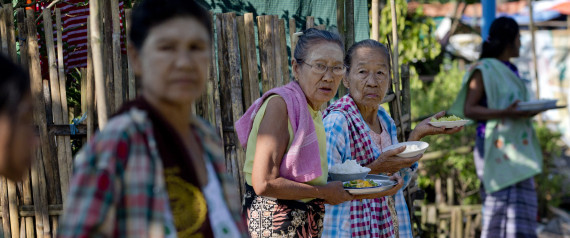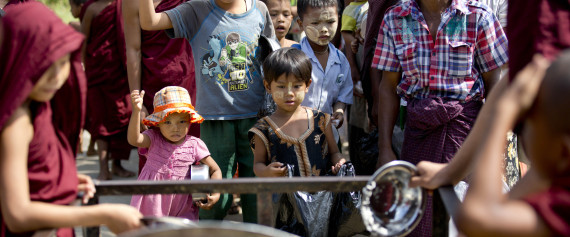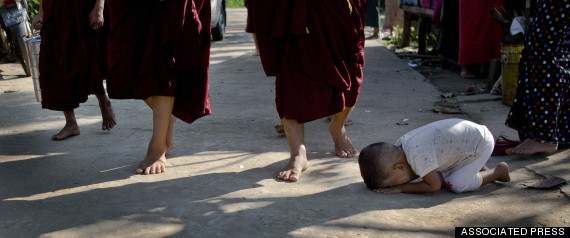By ESTHER HTUSAN Posted: 
HLAING THARYAR, Myanmar (AP) — "The food cart is coming!" the hungry little boy shouts, his face lighting up.More than 100 people sitting in the grass and beneath the dark midday shadows of giant trees turn to look at the nearby Buddhist monastery. As a monk moves through the gates with a huge pot of rice and curry, orphans, homeless children and jobless men and women line up with crumpled plastic bags.

The Charities Aid Foundation looked at wide-ranging giving patterns by respondents globally over a month-long period. It ranked countries based on the percentage of people who said they had donated money, volunteered or helped strangers in the month before they were surveyed.
In its latest World Giving Index, released Tuesday, the U.K.-based group said that Myanmar — turned into one of the world's poorest nations during a half-century of dictatorial rule, corruption and mismanagement — shared the top spot with the United States.

The report said that in Myanmar, 91 percent of those surveyed said they had recently donated money, No. 1 in the world. It tied with the U.S. under the survey when volunteerism and helping strangers were also considered. The foundations attributed Myanmar's giving to the deeply rooted charitable traditions of Theravada Buddhism, the country's dominant religion.

Giving monks money and food is a way for followers to earn merit. It enables monks, who cannot work, to spend their days meditating and reciting Buddhist prayers.
But in Hlaing Tharyar, a massive industrial zone outside the commercial capital, orange-robed men of faith are surrounded by suffering, and have given much of the food they receive to those in greater need.

Many of those in Hlaing Tharya were victims of Cyclone Nargis, which in 2008 swept away hundreds of thousands of people and their homes in the nearby delta region. Some migrated to Yangon and surrounding townships, hoping to find work at one of the many factories now popping up.
With more people than jobs, and no safety nets, large numbers ended up in the streets instead.
Every morning, just before dawn and then again just after, more than 50 monks and novices from Mahar Aung Myae monastery wind through the dark, uneven streets of their neighborhood to collect food from residents who stand in front of their small wooden shacks holding out offerings.
When the barefooted monks return to the monastery, they combine most of what they have gathered into a giant pot and bring it to those waiting outside their gates.

The child who first spots the food truck this sunny afternoon is around 6. A garbage picker, he survives on what others throw away.Through his dark smudged face, his wide eyes sparkle as he watches his bag being filled with food. Moments later he disappears, eager to fill his stomach. |

HLAING THARYAR, Myanmar (AP) — "The food cart is coming!" the hungry little boy shouts, his face lighting up.More than 100 people sitting in the grass and beneath the dark midday shadows of giant trees turn to look at the nearby Buddhist monastery. As a monk moves through the gates with a huge pot of rice and curry, orphans, homeless children and jobless men and women line up with crumpled plastic bags.

The monks ladle up food that was offered to them just hours earlier during their dawn collection of alms. That cycle of giving is part of what earned this impoverished Southeast Asian nation a seemingly unlikely title: the world's most generous nation.
The Charities Aid Foundation looked at wide-ranging giving patterns by respondents globally over a month-long period. It ranked countries based on the percentage of people who said they had donated money, volunteered or helped strangers in the month before they were surveyed.
In its latest World Giving Index, released Tuesday, the U.K.-based group said that Myanmar — turned into one of the world's poorest nations during a half-century of dictatorial rule, corruption and mismanagement — shared the top spot with the United States.

The index ranked 135 countries based on data from the Gallup World Poll, which last year surveyed 500 to 2,000 people in each of the countries involved. Most surveys, including the one conducted in Myanmar Sept. 24-Oct. 13, 2013, were of about 1,000 people. Myanmar's survey had a margin of error of plus or minus 3.4 percentage points, and three states representing less than 5 percent of the population were not included in the face-to-face interviews.
The report said that in Myanmar, 91 percent of those surveyed said they had recently donated money, No. 1 in the world. It tied with the U.S. under the survey when volunteerism and helping strangers were also considered. The foundations attributed Myanmar's giving to the deeply rooted charitable traditions of Theravada Buddhism, the country's dominant religion.

There are half a million Buddhist monks in Myanmar, making up about 1 percent of the country's population of about 50 million — a higher percentage than any other country.
Giving monks money and food is a way for followers to earn merit. It enables monks, who cannot work, to spend their days meditating and reciting Buddhist prayers.
But in Hlaing Tharyar, a massive industrial zone outside the commercial capital, orange-robed men of faith are surrounded by suffering, and have given much of the food they receive to those in greater need.

Myanmar hoped that after its military rulers handed over power in 2011, the lifting of Western sanctions would help speed development. But the infusion of billions of dollars in foreign aid and investment has in many cases increased the gap between the rich and the poor.
Many of those in Hlaing Tharya were victims of Cyclone Nargis, which in 2008 swept away hundreds of thousands of people and their homes in the nearby delta region. Some migrated to Yangon and surrounding townships, hoping to find work at one of the many factories now popping up.
With more people than jobs, and no safety nets, large numbers ended up in the streets instead.
Every morning, just before dawn and then again just after, more than 50 monks and novices from Mahar Aung Myae monastery wind through the dark, uneven streets of their neighborhood to collect food from residents who stand in front of their small wooden shacks holding out offerings.
When the barefooted monks return to the monastery, they combine most of what they have gathered into a giant pot and bring it to those waiting outside their gates.

Those who donate are better off than those who receive, but there is poverty on both sides. And while other monasteries sometimes give food they don't need to the poor, is it rare for one in an impoverished neighborhood to do so on a regular basis.
The child who first spots the food truck this sunny afternoon is around 6. A garbage picker, he survives on what others throw away.Through his dark smudged face, his wide eyes sparkle as he watches his bag being filled with food. Moments later he disappears, eager to fill his stomach. |
No comments:
Post a Comment